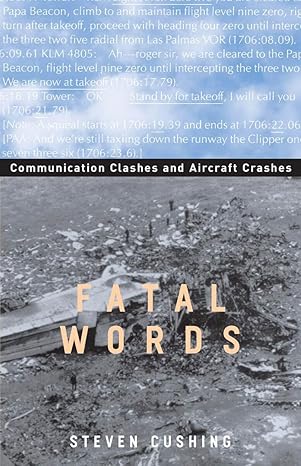
Fatal Words: Communication Clashes and Aircraft Crashes
Author(s): Steven Cushing (Author)
- Publisher: University of Chicago Press
- Publication Date: May 15, 1997
- Edition: New edition
- Language: English
- Print length: 176 pages
- ISBN-10: 0226132013
- ISBN-13: 9780226132013
Book Description
On March 27, 1977, 583 people died when KLM and Pan Am 747s collided on a crowded, foggy runway in Tenerife, the Canary Islands. The cause, a miscommunication between the pilot and the air traffic controller. The pilot radioed, "We are now at takeoff," meaning that the plane was lifting off, but the tower controller misunderstood and thought the plane was waiting on the runway.
In
Fatal Words, Steven Cushing explains how miscommunication has led to dozens of aircraft disasters, and he proposes innovative solutions for preventing them. He examines ambiguities in language when aviation jargon and colloquial English are mixed, when a word is used that has different meanings, and when different words are used that sound alike. To remedy these problems, Cushing proposes a visual communication system and a computerized voice mechanism to help clear up confusing language. Fatal Words is an accessible explanation of some of the most notorious aircraft tragedies of our time, and it will appeal to scholars in communications, linguistics, and cognitive science, to aviation experts, and to general readers.Editorial Reviews
From the Back Cover
On March 27, 1977, 583 people died when KLM and Pan Am 747s collided on a crowded, foggy runway in Tenerife, the Canary Islands. The cause, a miscommunication between a pilot and an air traffic controller. The pilot radioed, "We are now at takeoff", meaning that the plane was lifting off, but the tower controller misunderstood and thought the plane was waiting on the runway. In Fatal Words, Steven Cushing explains how miscommunication has led to dozens of aircraft disasters, and he proposes innovative solutions for preventing them. Cushing examines ambiguities in language and other causes of miscommunication between pilots and air traffic controllers. He looks at instances when a pilot or tower controller slips from technical aviation jargon into colloquial English, when a pilot inadvertently "tunes out" repeated instructions, when radios are misused, when a word is used that has different meanings, and when different words are used that sound alike. For example, he shows how a confusion involving to and two led to a fatal crash at a Southeast Asian airport. To remedy these problems Cushing proposes, for the short term, a visual communication system to supplement voice communication, one that would include a visual touchscreen interface. The technical details of a visual touchscreen prototype are included in an appendix. For the longer term, Cushing outlines an intelligent voice interface to filter conversations for potential confusions and provide real-time feedback to help clear up confusing language. Fatal Words is an accessible explanation of some of the most notorious aircraft tragedies of our time, and it will appeal to scholars in communications, linguistics, and cognitivescience, to aviation experts, and to general readers.
 Wow! eBook
Wow! eBook

